|
1999-2004 (Return to Web Text-ures) |
Click Here to return to |
|
1999-2004 (Return to Web Text-ures) |
Click Here to return to |
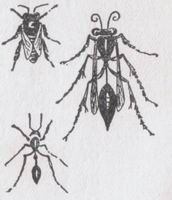 THE wasps, bees, and ants, as well as the
gall-flies, saw-flies, and a few other insects, are branches of the same family
tree, being doubtless all descended from some common ancestral stock that
flourished in long ago geological ages.
THE wasps, bees, and ants, as well as the
gall-flies, saw-flies, and a few other insects, are branches of the same family
tree, being doubtless all descended from some common ancestral stock that
flourished in long ago geological ages.
They are classed by man in what he calls the Order Hymenoptera, or Order of Membrane-winged Insects, -- a very misleading name, as other insects are quite as membrane-winged as these. The Hymenoptera resemble the general family of insects in possessing a distinct head, thorax, and abdomen, each of these parts having functions of its own.
They differ from other insects in the manner in which abdomen and thorax are united; also in the details of the mouth parts, in the wings, and in other parts of the body.
In the youth of their race the efforts of the
hymenopterous insects were directed toward the accomplishment of certain acts
that others of the insect folk did not care to perform.
The consequence of desires that progressed as they were gratified, aided by environment, was the gradual development of the general characteristics of the hymenopteran Order.
Again, in the early ancestral history of this Order, each division of it worked in a certain direction, pushed along by a combination of internal and external forces that finally resulted in the well-defined divisions of Bees, Ants, Wasps, etc., with characteristics more or less fixed. The wasps acquired the wasp form and the wasp nature. Their habits were wasp habits. The bees forsook uncertain lines of conduct and settled into indisputable beedom. The ants drew lines fast and firm about their family form and habits, and thus separated themselves from all other hymenoptera.
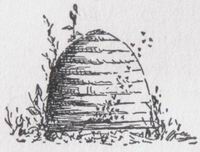 Early in their history there was no distinction
between bees and wasps. There were no bees, no wasps. There were insects
wavering, as it were, between becoming bees or becoming wasps, and some of
these, caring only for honey and pollen, in time crystallised into bees with the
necessary structure and mind for procuring a living of pollen and honey. Others,
more adventurous and more carnivorous in their appetites, crystallised finally
into wasps, with their strength, ferocity, and skill in capturing living prey.
Early in their history there was no distinction
between bees and wasps. There were no bees, no wasps. There were insects
wavering, as it were, between becoming bees or becoming wasps, and some of
these, caring only for honey and pollen, in time crystallised into bees with the
necessary structure and mind for procuring a living of pollen and honey. Others,
more adventurous and more carnivorous in their appetites, crystallised finally
into wasps, with their strength, ferocity, and skill in capturing living prey.
It must not be supposed that the tendency toward beehood resulted in the development of but one form of bee. Though all the beeward-tending insects preferred pollen and honey, not all of them devised the same way of getting and using their pabulum. There developed one class of bees where the females made holes in the ground, and buried in each a ball of pollen, in which one egg was laid.
In another class the female buried a mass of pollen in the ground, in which many eggs were laid. The young from these ate holes in the pollen mass and at length formed about themselves cocoons, which when vacated were stored with honey by the bees that did not abandon the nest, but continued to live in colonies or families. This is still the method of our bumble-bee whose race-childhood was not so clever, and who did not get so far along the road of progress as the hive bee. Some of the bumble-bees added wax to strengthen the covering to their nests and even to build more cells. But they still made primitive cup-shaped cells and it was left to the honey-bees to perfect the idea and construct waxen combs of hexagonal cells to contain their young and their food.
The bumble-bee, in producing a colony of workers
to advance the interests of the family and help to rear a numerous progeny, took
a long step ahead of the solitary little pollen-collector that makes a hole for
each larva.
But the bumble-bees die in the fall, -- all but the perfect females, that live to start each one a separate nest next season.
The hive bees took a long step in advance of the bumble-bees when they created a lasting colony, one which stored up provisions and survived the winter, ready to fly forth at the first sign of spring to continue the work of the hive, instead of having each year, to start it from the foundation.
The story of the bees is the story of the wasps. One class has stopped at the less intelligent stage of solitary existence, where the female digs a hole in the ground or otherwise constructs a nest, provisions it, and lays her egg.
Another class has taken the important step of living in colonies, its colony in one respect resembling that of the bumble-bee rather than the highly organised community of the hive bee. For the colony disappears at the close of the summer, only the perfect females surviving to begin the circle again next season.
 The social wasps build combs of hexagonal cells,
like those of the bees. But instead of secreting wax for it, they manufacture
paper of wood-fibre; and instead of standing the comb an its edge, most of them
suspend it mouth down.
The social wasps build combs of hexagonal cells,
like those of the bees. But instead of secreting wax for it, they manufacture
paper of wood-fibre; and instead of standing the comb an its edge, most of them
suspend it mouth down.
How came bee and wasp to build a similar comb of such different materials? And why does the wasp hang its comb mouth down where the bee stands its on edge?
Did all comb-makers originally hang their cells
mouth down? And did the idea of storing honey cause the bee to change the
position to prevent the honey from running out?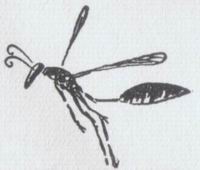
To this day the queen-bee cells hang mouth down, and they are the only cells in the hive that never contain honey!
Did the bee and the wasp get the idea of cell-making from some common comb-building ancestor who had not yet differentiated into a true bee or a true wasp; an ancestor wavering between paper and wax, some of whose descendants chose one and some the other; an ancestor wavering between pollen and insect food?
Or did the comb-building habit arise after bees were bees and wasps wasps, -- a like necessity resulting in a like construction?
One would like to turn back the pages of time for a glance at the primitive history of these remarkable creatures, but the book is closed and locked, only the page of to-day being available to those who can read it. From this page we learn that bees and wasps differ but very slightly from each other.
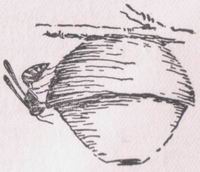 Indeed a novice might find it hard to decide
between certain insects, as to whether they were bees or wasps, were it not that
bees being pollen-gatherers; have provided themselves with implements for
pollen-gathering; they are peculiarly hairy, while wasps, to whom collecting
hairs would be a waste of protoplasm, have not clothed themselves with a
pollen-collecting coat.
Indeed a novice might find it hard to decide
between certain insects, as to whether they were bees or wasps, were it not that
bees being pollen-gatherers; have provided themselves with implements for
pollen-gathering; they are peculiarly hairy, while wasps, to whom collecting
hairs would be a waste of protoplasm, have not clothed themselves with a
pollen-collecting coat.
They have no hair-baskets on their legs and no brushes on legs or body for collecting pollen.
They are longer and more slender than bees, as a rule, and generally they wear a livery unlike that of the bees. Some of them have tongues for honey-gathering vying in length with the serviceable organ of the bee, and some of them, in tropical countries, build combs that are not suspended mouth down but are built in concentric spheres, the position of most of the cells being more like that of the honeycomb than like the ordinary wasp-comb. Some of them store food in their cells, and with some this food is a true honey.
Bees are probably the latest evolution in the insect world.
The Order Hymenoptera, on the whole the most
advanced of all Orders, is a late development according to the geological
records, and in this Order the wasps precede the bees in time, the marvellous
honey-makers being the last and the highest product of hymenopteran evolution.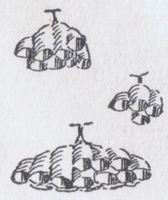
The wasps, in consequence of slight differences in their structure, have been artificially separated into two families, the true wasps and the digger wasps.
The true wasps can readily be distinguished by their wings, which are folded fan-like down the middle.
The digger-wasps are all solitary, while some of the true wasps are solitary, and the rest, belonging to the family Vespidae, are social.
The Vespidae live in communities and build a common habitation. There are three genera of them in the United States, one belonging to California, and the other two, Vespa and Polistes, to the country in general.
To the genus Vespa belong the hornets and yellow-jackets. These build nests of paper, enclosed by thick paper walls. The hornets of this country generally suspend theirs from a tree-branch or the roof of a building, while many of the yellow-jackets prefer a hole in the ground, though some species build, like the hornets, in the open air.
 Polistes builds also a paper nest, but she does
not enclose her combs by outer walls, as does Vespa.
Polistes builds also a paper nest, but she does
not enclose her combs by outer walls, as does Vespa.
There are a great many species of solitary wasps in the United States, and they are very difficult to classify. They do not build nests of paper, but bore holes in the earth or in wood, or make nests in hollow stems, or build them of mud against the walls of buildings or under stones or on bushes.
Wasps possess a more versatile, if lower, intelligence than bees. Bees have become crystallised, as it were; their habits are formed; they have arrived at perfection along their line, and therefore are in a condition of suspended development.
Not so wasps, -- they have not arrived; they are
arriving. So, while bees stand highest structurally and socially, their
communities organised and in working order from Wax-secreting to honey-making,
wasps are yet blazing a way through the unknown wilderness of wasp
possibilities. They yet have their problems to solve and are yet to a far
greater extent than bees dependent upon their wits to see them safely through
their little span of life.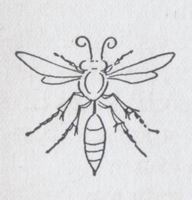
Although the solitary wasps are so numerous in species, the social wasps are those best known to literature. Like the bees, their strength lies in numbers.
They make elaborate and wonderfully ingenious habitations for themselves, and rear their progeny under the influence of the home. They can thus accomplish results impossible to creatures of solitary habits.
The social wasps have always been objects of interest, because objects of fear, to man.
One wasp may be ignored; not so a thousand wasps.
They command attention and even prompt and energetic action when circumstances bring men in contact with them.
| Masaridae | |
| Solitary: | Eumenidae |
| Vespa | |
| Social-Vespidae: | Polistes |
| Polybia (California) |
II. SPHECINA, FOSSORES, OR DIGGER-WASPS:
All solitary (many genera).